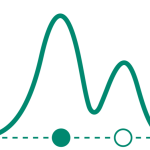
What is mechanistic modeling in chromatography?
Mechanistic models use computer simulations to decrease the number of experiments needed during process development. The simulations are based on known physiochemical phenomena involved in chromatography. Mechanistic modeling is a mathematical representation of the physiochemical transport and interactions that occur during chromatography. For example, this methodology uses differential equations that describe how molecules move between resin beads and inside the bead pores. It also uses adsorption isotherms to quantify how molecules compete for ligands when binding.
Why use mechanistic modeling in downstream process development?
With mechanistic models, process developers can get a better understanding of both the entire process and the parameters that can influence the process with a smaller number of experiments.
That way, process development can become faster, more scientific, and more reliable. The ability to anticipate and model scale effects is another advantage of mechanistic modeling over multivariate data analysis (MVDA). Mild extrapolations are also covered in the mechanistic modeling framework. Possible applications include prediction of step elution conditions for ion exchange chromatography, facilitation of tech transfer by predicting scale-up from lab to process chromatography columns and explaining deviations in manufacturing.





